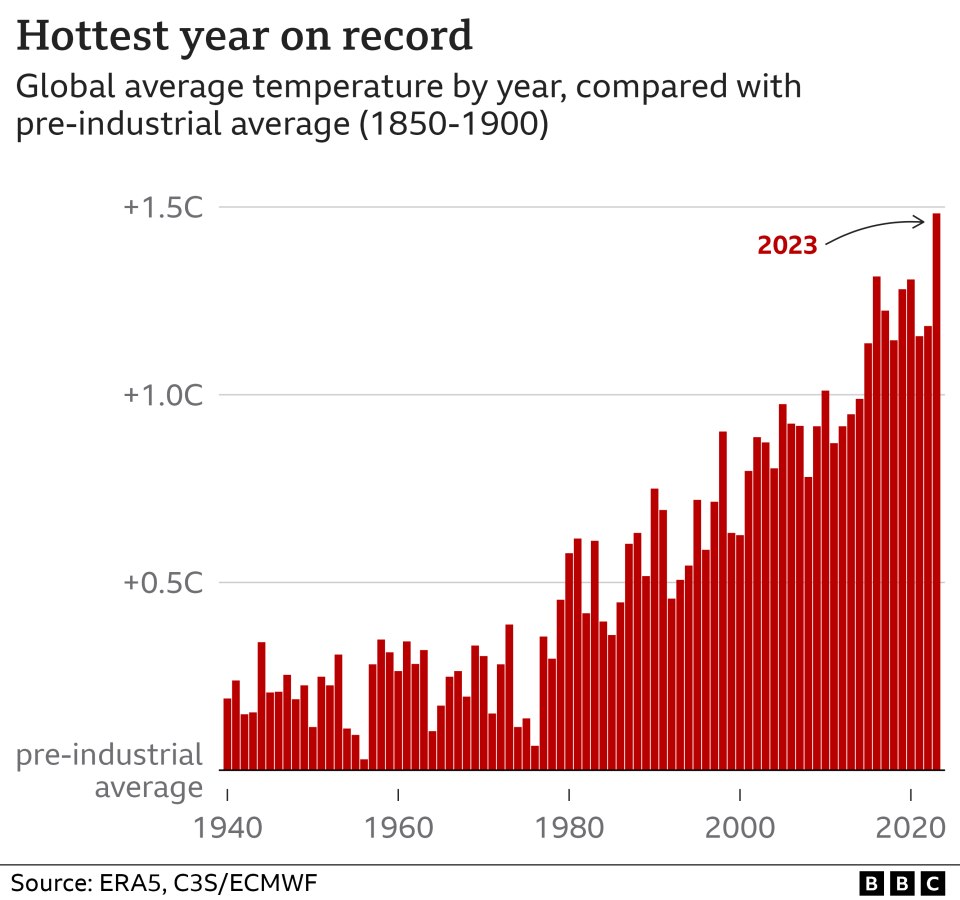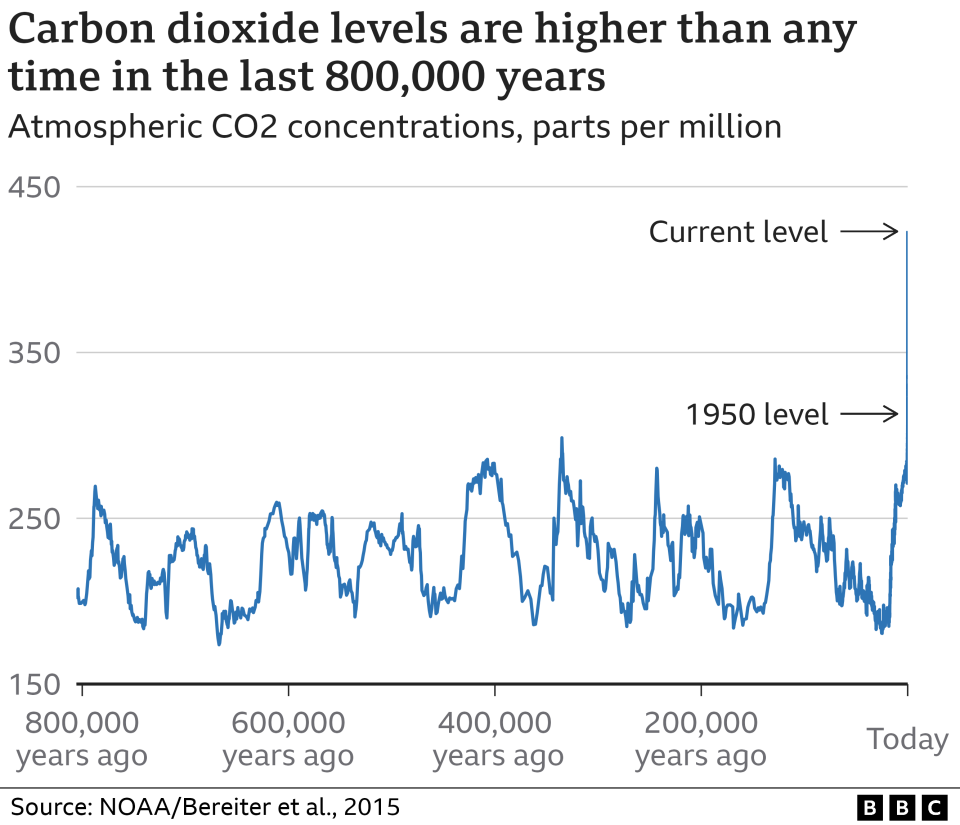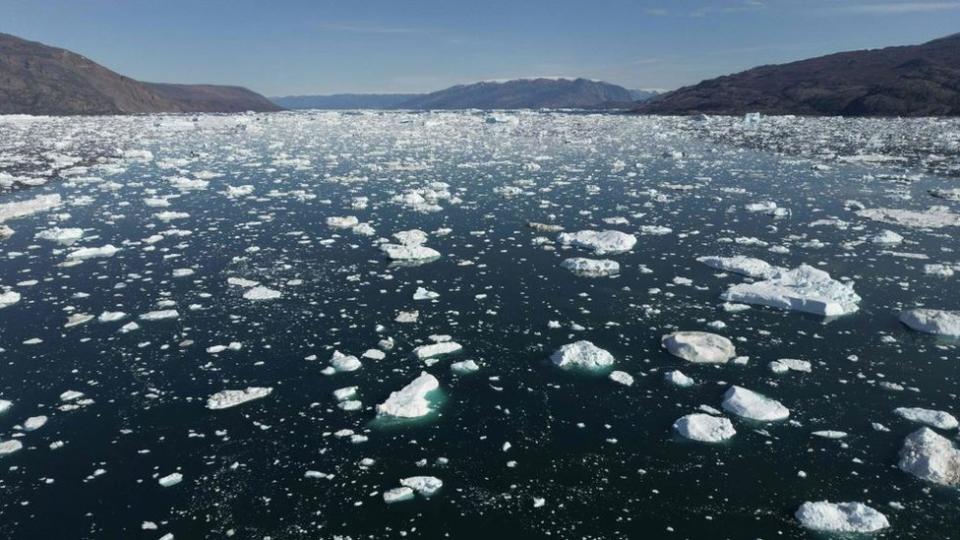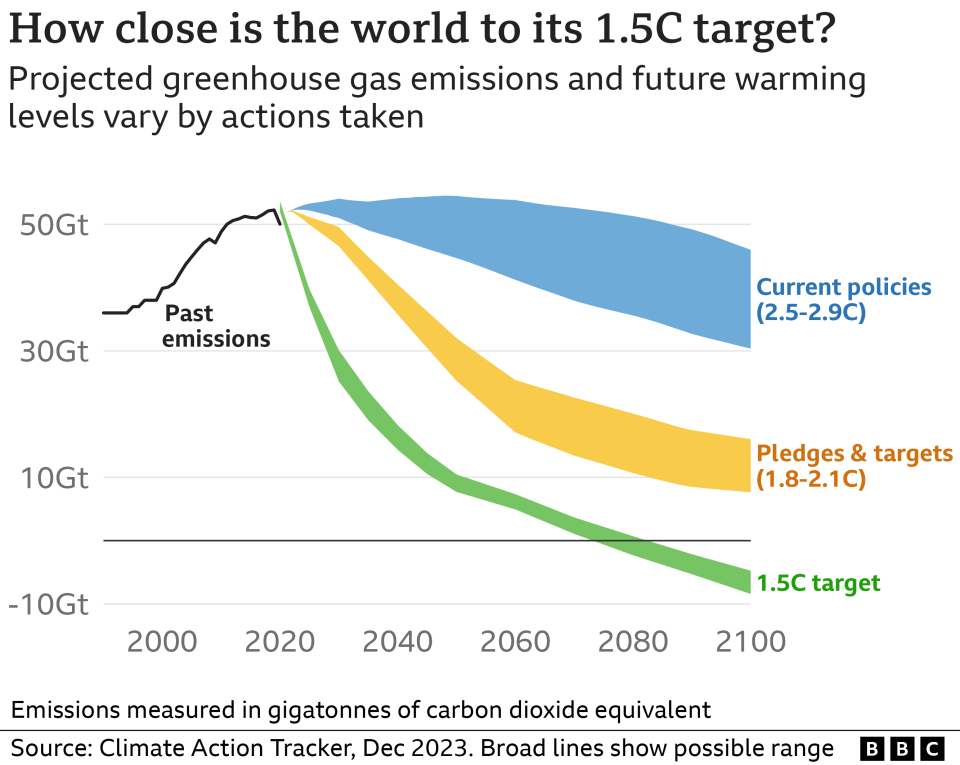Human activities are causing world temperatures to rise, with more intense heatwaves and rising sea-levels among the consequences.
Things are likely to worsen in the coming decades, but scientists argue urgent action can still limit the worst effects.
What is climate change?
Climate change is the long-term shift in the Earth’s average temperatures and weather conditions.
Over the last decade, the world was on average around 1.2C warmer than during the late 19th Century.


[BBC]
How are humans causing climate change?
The climate has changed naturally throughout the Earth’s history. But natural causes cannot explain the particularly rapid warming over the last century, according to the UN’s climate body, the Intergovernmental Panel on Climate Change (IPCC).
This warming has been caused by human activities, mainly the widespread use of fossil fuels – coal, oil and gas – in homes, factories and transport.
When fossil fuels burn, they release greenhouse gases – mostly carbon dioxide (CO2). This CO2 acts like a blanket, trapping extra energy in the atmosphere near the Earth’s surface. This causes the planet to heat up.
Since the start of the Industrial Revolution – when humans started burning large amounts of fossil fuels – the amount of CO2 in the atmosphere has risen by about 50%, far above levels seen in the Earth’s recent history.
The CO2 released from burning fossil fuels has a distinctive chemical fingerprint. This matches the type of CO2 increasingly found in the atmosphere.


[BBC]
What are the effects of climate change so far?
A global average temperature increase of 1.2C might not sound much.
However, it has had a huge effect on the environment, including:
People’s lives are also changing.
For example, parts of East Africa recently suffered their worst drought in 40 years, putting more than 20 million people at risk of severe hunger.
In 2022, intense European heatwaves led to an abnormal increase in deaths.
Why does 1.5C matter and how will future climate change affect the world?
The more the world warms, the worse the impacts of climate change become.
Limiting long-term average temperature rises to 1.5C is seen as particularly important. In a landmark agreement signed in Paris in 2015, almost 200 countries pledged to try to limit global warming to that amount.
The science is not completely certain, but according to the UN the consequences of 2C global warming versus 1.5C could include:
Extreme hot days could become on average 4C warmer at mid-latitudes (regions outside the poles and tropics), versus 3C at 1.5C
Sea-level rise could be around 0.1m higher than at 1.5C, exposing up to 10 million more people to events including more frequent flooding
More than 99% of coral reefs could be lost, compared with 70-90% at 1.5C
Twice the number of plants and vertebrates (animals with a backbone) could be exposed to unsuitable climate conditions across more than half their geographical area
Several hundred million more people may be exposed to climate-related risks and susceptible to poverty by 2050 than at 1.5C.
The call to limit temperature rise to 1.5C was partly designed to avoid crossing so-called “tipping points”.
It is not clear exactly where they sit, but once these thresholds are passed, changes could accelerate and become irreversible, such as the collapse of the Greenland Ice Sheet.


The Earth’s poles are especially vulnerable to rising temperatures [Getty Images]
About 3.3 to 3.6 billion people are highly vulnerable to climate change, according to the IPCC.
People living in poorer countries are expected to suffer most as they have fewer resources to adapt.
This has led to questions about fairness, because these places have typically only been responsible for a small percentage of greenhouse gas emissions.
However, knock-on impacts could be felt over wide areas. For example, crop failures linked to extreme weather could raise global food prices.
What are governments doing about climate change?
In a landmark agreement signed in Paris in 2015, almost 200 countries pledged to try to limit global warming to 1.5C.
To keep global warming to 1.5C, “net zero” CO2 emissions should be reached by 2050. Net zero means reducing greenhouse gas emissions as much as possible, and removing any remaining emissions from the atmosphere.
Most countries have, or are considering, net zero targets.
However, greenhouse gas levels are still rising quickly and the world is “likely” to warm beyond 1.5C, the IPCC says.


[BBC]
However, there has been progress in some areas, such as the growth of renewable energy and electric vehicles.
World leaders meet every year to discuss their climate commitments.
In 2023, countries agreed to “contribute” to “transitioning away from fossil fuels” at the COP28 summit in Dubai, although they are not forced to take action.
From 11 November 2024, governments will gather at COP29 in Baku, Azerbaijan. A major goal is to agree a new deal on the funds that richer countries should give to poorer nations to help them tackle climate change.
What can individuals do about climate change?
Major changes need to come from governments and businesses, but individuals can also help through actions like:


[BBC]
Top image from Getty Images. Climate stripes visualisation courtesy of Prof Ed Hawkins and University of Reading.
